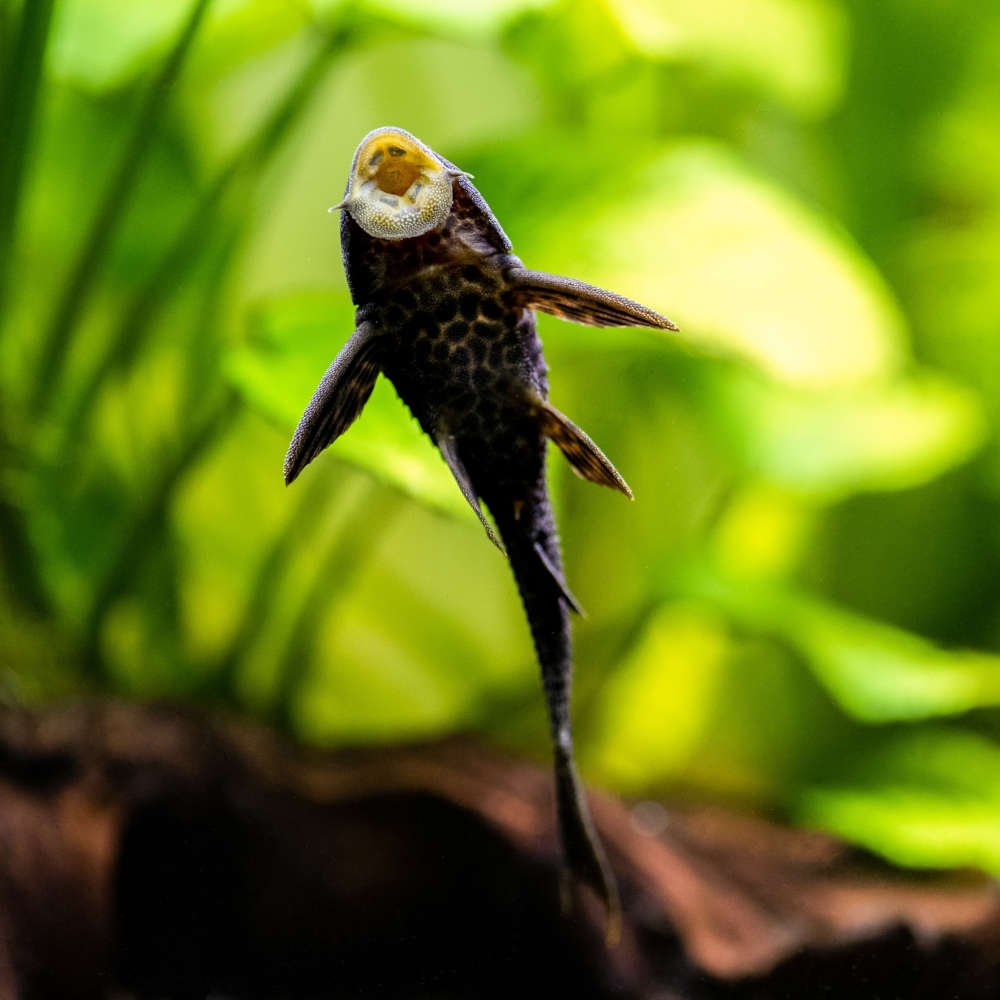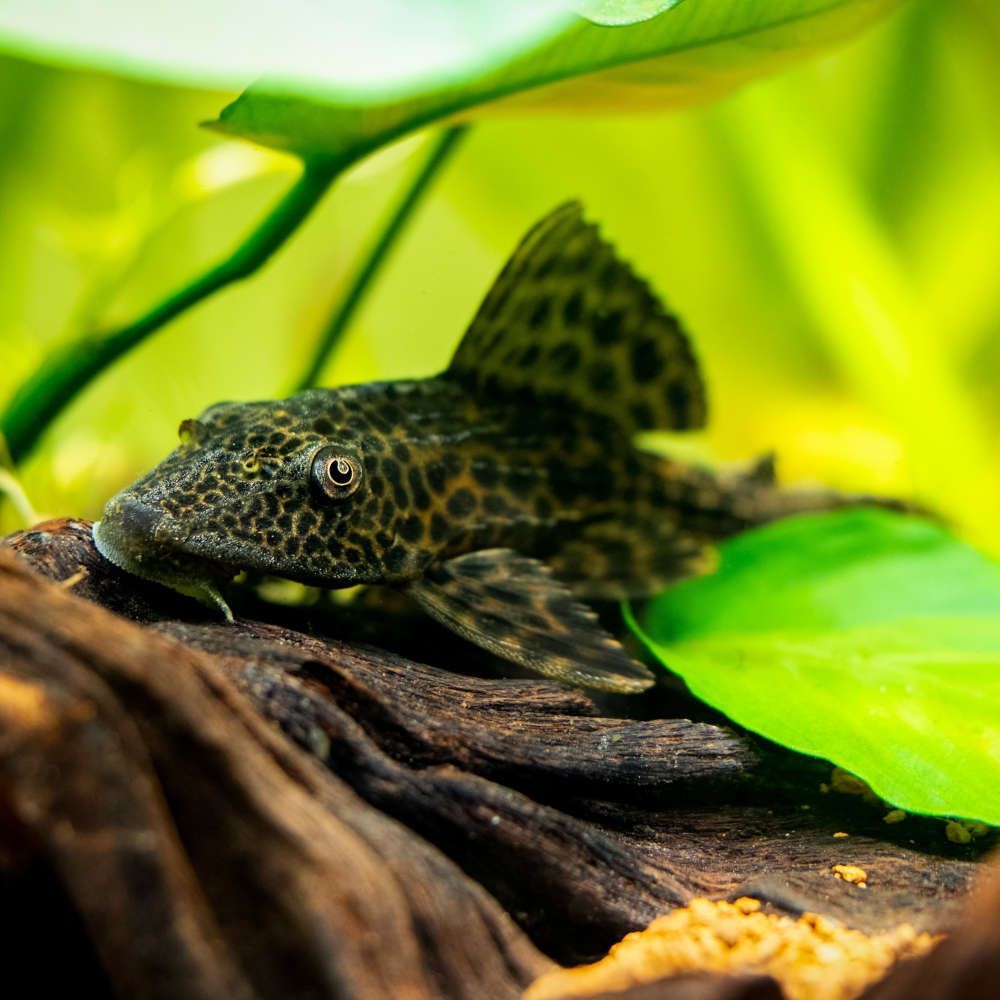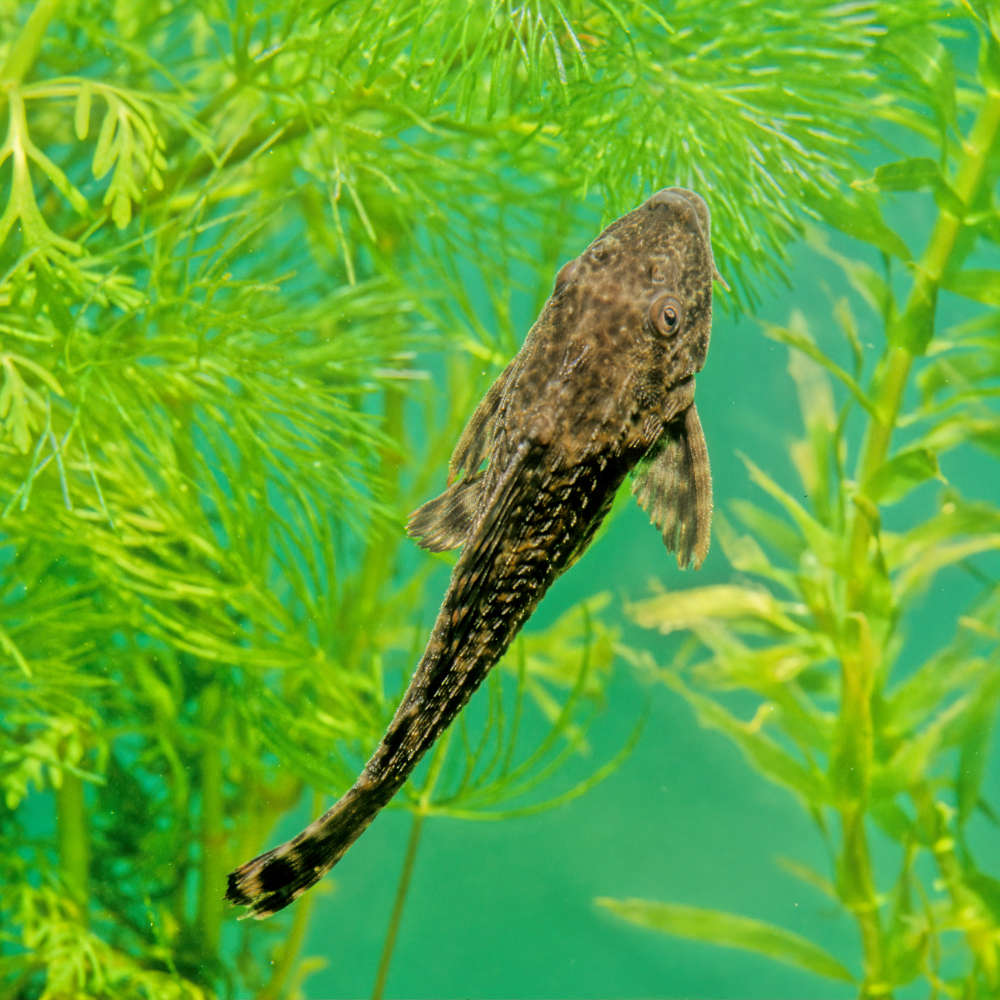It is a treat to the eyes because of its fun antiques at night. So, you won’t ever feel bored with this buddy around.
Now, if you want to adopt this fish, let’s get right into it!
What is a Pleco Fish?
The pleco fish is one of the popular algae-eating species for freshwater tropical tanks. This attractive armored species is perfect for both experienced and novice aquarists owing to its bare minimum maintenance requirements.
| Origin | Guianan coastal drainage, South America |
| Order | Siluriformes |
| Family | Loricariidae |
| Scientific Name | Hypostomus plecostomus |
| Common Names | Pleco fish, sucking catfish, suckermouth catfish, spotted catfish, sea hasar, Plecostomus, janitor fish, algae sucker/eater, municipal fish, sweeper fish, crocodile fish |
| IUCN Red List Status | Not Evaluated |
| Appearance | Light brown with dark blotches, downturned mouth with a sucker, flat belly, expansive fins |
| Size (Adult) | 28 cm (11 in) Max: 50 cm (19.7 in) |
| Lifespan | 15 years in captivity |
| Temperament | Peaceful when young, aggressive when older and toward own species; territorial |
| Tank Level | Bottom dweller |
| Water Temperature | 68-82 °F (20-28 °C) |
| pH Level | 6.5-8 |
| Water Hardness | Up to 15 dGH |
| Care Level | Easy |
| Minimum Tank Size | 150 gallon |
| Tank Environment | Sandy substrate, lots of shade and hiding spots, driftwood and caves, dim lighting, and strong filtration |
| Diet | Omnivorous with herbivorous preferences |
| Tank Mates | Other similar-sized, semi-aggressive, and aggressive species that stays in other water columns |
What is the Natural Habitat of Pleco Fish?
The pleco fish is naturally found around the tropical fresh and brackish waters in the northeastern areas of South America.
It’s spotted in Guianan coastal drainage of northeastern Brazil and in Trinidad and Tobago. The fish is also native to the Guyana waters and coastal rivers, Suriname coastal river, and Orinoco river.
It is assumed that it’s an invasive species in several Asian, European, and American nations. It’s believed to be introduced through aquarium release or that they escaped from aquaculture facilities.
However, according to some they were separate species and misidentified as plecos.
Which family does a Pleco Fish belong?
The catfish is a member of the Loricariidae family under the Siluriformes order. While its binomial name is Hypostomus plecostomus, it’s known by several other names like these:
- Pleco fish
- Suckermouth catfish
- Sucking catfish
- Spotted catfish
- Plecostomus
- Sea hasar
- Janitor fish
- Municipal fish
- Sweeper fish
- Crocodile fish
- Algae eater/sucker
Fun Fact: While plecos are well-renowned algae eaters, they don’t consume blue algae.
How does a Suckermouth Catfish Pleco Fish look?

Now, if you’re interested in knowing about the looks of the pleco fish, let’s get started…
What is the Size of a Pleco Fish?
In general, this catfish can grow up to 28 cm (11 in). However, the maximum reported size is 50 cm (19.7 in).
What is the Color of Pleco Fish?
The pleco fish usually has a light brown body with lots of dark blotches, which seem like spots and/or stripes.
Some varieties might lack the dark blotch completely. Some have yellow or tan blotches. There’s an albino pleco as well.
What are the Features of Pleco Fish?
Other than the belly and lower part, the entire body of the elongated pleco fish is covered with bony plates or armor-clad scales. The ridged scales give it a spiky look.
It flaunts a tall sail-like dorsal fin, a large head, and an underturned suction-like mouth which is used for algae-eating. With its mouth, it can stay suctioned on flat surfaces and breathe. It’s also a facultative air breather.
The species also sports small eyes that are set high on the head. When it rolls its eyes inside the socket, it looks like it’s winking. Besides that, it has expansive fins and a flat stomach.
What is the difference between a male and a female Pleco fish?
It’s difficult to differentiate sexually. However, here are a few differences:
The genital papilla of the male is small and thick, protruding from its undercarriage like a stub. The female genital papilla lies flat or recessed. However, only experts can notice these differences.
Some say that the female fish has a rounder and larger belly than the skinny and slender male. But this comparison is valid when two specimens are of the same age. Moreover, a sick or underfed female might be identical to a male.
Others think the male fish has more developed, thicker, and reddish pink pectoral fins than the female.
What is the Behavior of Pleco Fish in the Tank?
The bottom-dwelling fish is peaceful when young. It can get along with all sorts of tank mates.
However, as the nocturnal scavenger grows, it becomes aggressive and territorial toward its own species, similar-looking fish, and other intruders in its water column.
It usually likes to stay on its own and constantly eats when awake.
What is the Lifespan of Pleco Fish?
In captivity, it’s known to live for 15 years. However, in the wild, it can survive even more.
Author’s Note
Since pleco fish are sold young and small, they look quite similar to the Ancistrus. The only obvious differences are:
- A pleco doesn’t have spines on its head and is bigger, unlike Ancistrus.
- It has a conical face. Ancistrus has a rounded face.
- It has a slightly forked tail. Ancistrus has a triangular tail.
How to take care of a Pleco Fish?

Now, if you’re excited to introduce this fish to your home aquarium, let’s prepare the perfect home for it…
What is the recommended Tank Size for Pleco Fish?
You can keep the young pleco in a 75-90 gallon tank. However, to help the fast-growing fish reach its maximum capacity, house it in a 150-gallon tank.
If you want to add more bottom-dwelling species, consider getting a bigger tank.
What is the Water Chemistry for Pleco Fish?
To keep your pleco healthy, keep an eye on the water parameters and maintain the following:
- pH Levels: 6.5-8
- Water Temperature: 68-82 °F (20-28 °C)
- Water Hardness: Up to 15 dGH
- Ammonia: 0 ppm
- Nitrite: 0 ppm
- Nitrate: Less than 20 ppm
What is the Tank Environment for Pleco Fish?
Now, let’s focus on creating the right ambiance so your pet fish feels at home…
Which Substrate do Pleco Fish need?
To mimic its natural habitat, use fine sand as a substrate. Although it doesn’t mind gravel substrate, it may still get hurt accidentally.
Which Plants do Pleco Fish need?
The pleco loves to be in a planted aquarium for shade and shelter. However, use plants with hardy stems, roots, and broad leaves like Anubias, Java fern, and Amazon sword.
Otherwise, it might uproot and eat them. It doesn’t usually attack plants but might eat them if hungry.
What Lighting do Pleco Fish need?
Use subdued to moderate lighting in the tank to make your pleco comfortable. Place lots of floating plants to disperse the light. During the after-hours, use a red light to watch your fish.
Which Décor does Pleco Fish need?
Use riverbed decor like:
- Driftwood: The fish will munch on it for fiber. It also grows algae – another important dietary need.
- Natural caves: It’s necessary for the fish to rest, hide from light, and be protected from other fish.
- Big roots and flat rocks: They work as resting places.
Avoid wood that leaches toxins like eucalyptus.
What is the Filtration system for Pleco Fish tank?
Since the fish constantly munches on wood or algae, it releases lots of waste and bioload. So, opt for a powerful filtration system. In my experience, over-filtering (using a way more powerful filter than usual) is the trick to keep your pleco fish healthy.
Along with that, you must also perform 30-50% weekly water changes. If the water gets dirty faster, perform it more frequently.
What is the Water Flow Rate for Pleco Fish?
Maintain a strong water flow to keep the tank well-oxygenated and clean from toxins. Don’t worry; your pleco fish can use its mouth to stay put on the aquarium surface and avoid getting flown with the current.
Care Tip: The pleco fish is a great algae eater only during its youth. It loses its ability to scrape algae as it grows old. So, don’t depend on it solely to clean the algae in your tank.
What do Pleco Fish eat?
Although the pleco is a great algae eater, don’t try to sustain it on algae alone. The omnivore has an enormous appetite and mostly prefers a vegetarian diet. Here are a few components to include in its diet:
- Algae wafer
- Sinking pellet
- Blanched vegetables (spinach, shelled peas, cucumbers, green beans, and lettuce)
- Fruit
- Live worms (bloodworms and earthworms)
- Small, baby, and newly hatched crustacean
- Insect larvae
Feed it two pinches of food in the evening before turning off the lights. Make sure most of its diet is vegetarian with slight variations of carnivorous feed.
What are the Tank Mates for Pleco Fish?
The young pleco fish can coexist with several other fish. However, with age, it becomes more territorial and aggressive. Besides, the fish has a fast growth rate. So you must choose similar-sized tank mates that occupy different water columns.
Some great options are:
- Dwarf gourami
- Honey gourami
- Flowerhorn cichlid
- Green terror cichlid
- Oscar fish
- Neon tetra
- Congo tetra
- Hatchetfish
- Silver dollar fish
- Platy fish
- Rainbowfish
- Scalar
Which Tank Mates to Avoid for Pleco Fish?
Don’t house the fish with the following species in the same tank
- Bottom-dwellers: The territorial fish may chase away any being that is around its space.
- Laterally flattened fish: The fish removes slime from them when they’re asleep.
- Crustaceans: The fish prey on them.
Namely, you must avoid:
- Cory catfish
- Other plecos
- Shrimp
- Snail
- Crab
- Goldfish
- Discus fish
- Freshwater angelfish
What are the Common Diseases for Pleco Fish?
The suckermouth catfish is hardy and easy to take care of. However, it’s still vulnerable to a few more diseases other than the common ones like ich, fin rot, and columnaris. To help your pet fish live up to its greatest lifespan, beware of these diseases…
| Disease Name | Causes | Symptoms | Treatment |
|---|---|---|---|
| Dropsy | Infection, poor water quality, stress | Swollen belly, ulcers, protruding scales, redness near fins and vents | Quarantine, improve diet, regular partial water changes, medication |
| Sunken abdomen | Underfeeding | Sunken abdomen | Provide more nutritious food |
| Bloated abdomen | Constipation, obesity | Bloated abdomen | Cut down supplemental feed, feed more fibrous food |
Quick Tip: The pleco is sensitive to copper-based medicine, so avoid it.
Most of these diseases are somehow related to poor water chemistry. So, regularly check the water with test kits.
How to Breed Pleco Fish in an Aquarium?
Plecos are extremely difficult to breed at home aquariums. You need a massive tank for breeding, and a pair might fight due to their territorial nature. They also dig deep burrows in the wild to lay eggs, which is difficult in captivity. But if you still want to try breeding it, here’s the guide:
1. Pairing
You can try to get a bonded pair, which makes breeding much easier. Some suggest getting a young male and female bonded naturally. But for that, you must get the genders identified by a professional.
2. Pair Conditioning
Keep the pair on a nutritious diet of quality-grade pellets, algae-based food, and some frozen or live feed for several weeks.
3. Breeding Tank Preparation
Prepare a 300-gallon tank with lots of PVC pipes, hollow driftwood, and caves as hiding and egg-laying spots.
Maintain the following water parameters:
- Water Temperature: 80-84 °F (27-29 °C)
- pH Levels: 6.5-7.5
- Water Hardness: Moderate
4. Mating & Egg Caring
When they’re ready to mate, the male pleco will become territorial and chase the female. He also chooses and cleans a spot for egg-laying.
If the female is receptive, she lays up to 300 eggs at the chosen spot, and the male externally fertilizes them. Both take turns to guard the eggs. The male fans the eggs and gets rid of moldy ones.
5. Hatching
Once the eggs hatch, you’ll notice a 5 mm (0.2 in) long fry. The fry feed on the mucus of their parents’ bodies.
The parent fish takes care of the juvenile until they can be independent. However, many suggest separating the fry and parents to avoid them getting eaten.
6. Fry Care
Feed the fry a high-protein diet with brine shrimp, microworms, sinking tablets, and algae-based feed.
How to Buy Pleco Fish?
Opt for specimens with signs of good health like these:
- Stays near the bottom and attached to the aquarium surface
- Has clear eyes
- Has good appetite
Avoid specimens that show these signs:
- Color loss
- Cloudy eyes
- Frayed/disintegrated fins
- Fungus or white spots on mouth or body
- Sunken abdomen
- Bloated
A word from FishInAquarium
The one-of-a-kind pleco fish not only looks majestic and has cleaning abilities, but it’s also a major conversation starter.
It’s also pretty fun to feed this constant muncher. The sucker will never fail to amaze how much it can chew and chomp on driftwood with its cute little mouth.
So, if you don’t want to miss out on its cuteness, get yourself an aptly-sized tank and get this regal-looking baby home!
With that said, if you found this article interesting and helpful, share it with aquarist friends. If you have any more questions, email us, and our team will be in touch soon!


